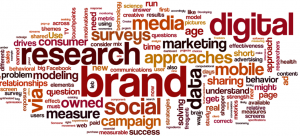Third in a three part series on the future of marketing research practices. To read part one on how emerging media behaviors are affecting research practice, click here. To read part two on how new marketing questions drive research approaches, click here. To see a table of how marketing research practice has changed over the past 30 years click here.
To understand how marketing research approaches need to evolve, let’s consider six marketing questions and let me share the contemporary problem solving approaches I would offer.
Q. How do I measure the relative impact of traditional, paid digital, earned and owned media?
A. This is a marketing mix modeling question however, not all modeling approaches are geared to a digital, social, and mobile age. The essential ingredients to getting the right answer are using a multi-stage modeling approach and having digital and social data streams that follow well thought out specifications. For example, TV drives search which drives webpage visits which drives sales. Hence, TV advertising has both a direct and indirect effect on sales.
Q. How do I encourage amplification of brand communications via consumer sharing?
A. You need to measure the sharing behavior and classify the content being shared. Someone like Kraft might find that recipe ideas with pictures get shared more than other communications and then redesign their strategies regarding Facebook page updates, Pinterest pictures, and owned media content accordingly. You might also study sharing behavior using biometrics (observe emotional response while sharing), and you could have users answer a few short questions, say, on their smartphone.
Q. How can I improve the effectiveness of my digital campaign in flight?
A. Create a campaign taxonomy (creative elements, touchpoints, ad network, target audience, type of placement such as run of site vs. behavioral targeting via real time bidding) and then analyze the results after the first 5 days or so as if it were a conjoint study. In fact, you might even consider the first few days of the campaign to be your copy test. Use surveys triggered by ad exposure to understand which creative elements are most memorable, leading to correct brand recall.
Q. What does my brand stand for in the minds of the consumer?
A. A great question that needs to be approached from a number of angles to get a complete and correct picture. Use:
- Trackers with brand attribute lists
- Social media conversation to understand the natural way people talk about your brand
- Use brain science approaches to measure semi-conscious connections in the consumer mind
- Profile the interests of those who liked your brand page on Facebook.
Q. How do I measure brand health and the strength of relationships?
A. The key need is to create a measurable model of what brand success looks like in a digital, social, and mobile age. Each component of brand success must be translated into a metric that is unambiguous, so movement is not subject to multiple interpretations. Include relationship metrics as consumer marketers can now built one to one relationships with consumers via social and owned media. It is likely that the brand health “dashboard” will contain measures such as your brand equity metric from surveys, a measure of winning the purchase (and why) from in the moment mobile surveys, the association of your brand with positioning themes, and the strength of relationships via measuring the numbers and activities of those who have joined your brand in social and owned media.
Q. What is the relative effectiveness of different digital touchpoints and why? When do I commit in a big way to mobile?
A. This will require monitoring behavior via metering software on each screen a user has (just now starting to become available), web metrics from a publisher(s) to calibrate the metered data, and surveys to get at motivations and satisfaction.. The advertiser should also validate the results with experiments where advertising is systematically run on different screens and where the effect is judged via either digital conversions (hard today because few can link users across screens) or with pop-up surveys.
So what are the recurring themes to these problem solving approaches that can serve as a compass for research retooling in a digital, social, mobile age?
- A new measurable model of brand success across paid, owned, and earned media that feeds brand KPI tracking, marketing mix modeling, and campaign assessment
- Integration and synthesis of surveys, social media data, and digital data
- Increased use of short survey (via mobile or in web page questioning and soon, wearable technology) and no survey approaches (social, digital, frequent shopper data)
- Developing a near real time cadence to support Marketers seeking campaign optimization
- Leveraging behavioral economics and brain science into new strategies about what matters.
- Anonymized merging of ad exposure with digital conversion activity or frequent shopper data to determine what works.
- Keeping the organization human-centered and future-focused by always thinking about multi-screen behaviors and motivations where the user is in control of these choices.
Thanks to information technology, each problem solving approach is within reach. No database is too big to handle, no Bayesian analytics are too computational intensive, no timeline is too short to make performance measures available on any screen.
Historically, marketing researchers run projects. We must go beyond the project to THE BUSINESS QUESTION as the organizing principle, where all relevant data will be brought together into synthesized insights and immediate action plans.
Lean forward researchers will view this as an age of opportunity as each new question and problem-solving approach offers the potential to disrupt the existing pecking order…of suppliers, of agencies, and the hierarchy on the client side.

